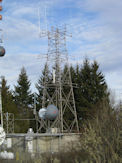Repeater Technical Information
Striped Peak Site Equipment |
|||||||||||||||||||||
|
|||||||||||||||||||||
| Forks Site Equipment | |||||||||||||||||||||
|
|||||||||||||||||||||
Remote Receiver Project With the exception of parts of the west end of Clallam County, the repeater’s transmitted signal is heard throughout the area with little difficulty, even with hand-held radios. For mobiles and base stations, accessing (also known as ‘hitting’) the repeater usually requires little difficultly as well. However, with the advent of affordable hand-held radios, many hams now commonly utilize hand-held radios for most of their VHF and UHF communications needs. This presents a problem with accessing the repeater, because even though repeater users using hand-held radios can hear the repeater well in many locations, that does not necessarily mean that repeater users will be able to be heard loud and clear through the repeater at that location. Geographic and man-made terrain (hills, buildings, etc.) can block a hand-held radio’s signal far more easily than a mobile radio or base station’s signal due to RF power and antenna constraints, preventing the user from accessing the repeater reliably. This commonly results in a weak and scratchy signal heard by everyone else. There are many solutions to this problem however, most of them very costly. An affordable option used in this case is to install remote receivers. In its simplest configuration, a repeater’s equipment is all located at the same physical site, where it receives a signal on the input frequency, and re-transmits the signal out over the repeater’s output frequency. For a repeater with remote receivers, it operates the same as described, but the repeater receives signals on the input frequency from not only the main repeater site, but also from additional remote locations as well. By placing remote receivers closer to users of the repeater, the repeater’s receive coverage is drastically enhanced. One of the most common misconceptions of what is being accomplished here is that the repeater’s transmit coverage (otherwise known as the user’s ability to hear the repeater) will be improved as well. In this design, that is not the case - this design only improves receive coverage - the user’s ability to access the repeater only. Everyone will still hear the repeater from Striped Peak - the idea here is to localize the repeater’s receiver to closer locations to the user than the main receiver location. Each remote receiver, along with the main receiver, has its own unique CTCSS tone required for repeater access. Whenever a user keys their radio with a specific CTCSS tone, all of the receivers in the system listening on the input frequency will listen, but only one of them will pass the signal on to the main transmit site. A remote receiver is basically two radios connected together - a VHF receiver and UHF transmitter. Whenever a VHF signal is received on the repeater’s input frequency with the appropriate CTCSS tone (Carlsborg being 77Hz for example), the audio from that signal is sent from the VHF radio over to the UHF radio, transmitting out on a UHF link frequency. This UHF link frequency is monitored by a link radio at the main site (Striped Peak in this case), and will re-transmit signals heard from the remote receivers out over the air on the repeater output frequency. At the project’s current state, the W7FEL repeater system consists of three receivers - the main receiver at Striped Peak, the Ellis Mountain remote receiver, and the Carlsborg remote receiver. Whenever the main receiver is being used, a ‘single beep’ courtesy tone will be heard, and whenever any of the remote receivers are being used, a ‘douple beep’ courtesy tone will be heard. To determine which remote receiver is being used during a QSO, the Ellis receiver will have a longer squelch burst upon dekeying - the Carlsborg receiver will only have a couple quick clicks upon dekeying. For site locations and coverage, see the ‘Location & Coverage’ page for details. |
|||||||||||||||||||||
Please contact the Repeater Trustee for additional technical information. |
|||||||||||||||||||||
